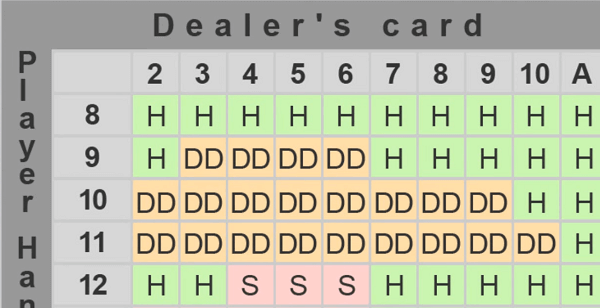

Ask anybody who doesn’t gamble seriously to name the first casino game that comes to mind. You’ll inevitably hear blackjack mentioned first and foremost.

No, you do not have to count cards to be a better blackjack player. The single most important thing to do is learn basic strategy. If you learn the correct plays for hitting, standing, doubling down, splitting pairs, and surrender when it is offered you will be playing at about half of one percent. That is twice as good as craps line bets or baccarat.
Perhaps the ubiquity of playing the game of blackjack stems from childhood games of Twenty-One, which is one of the first card games a child becomes acquainted with. Or maybe blackjack has become so popular because of its penetration in wider pop culture.
With so many Hollywood films famously showing audiences the art of card counting — from a savant’s coming out party in “Rain Man” (1988) to a team of MIT math whizzes toppling Sin City casinos in “21” (2008) — plenty of people who have never visited Las Vegas still know the ins and outs of blackjack.
But while anybody can learn how to hit, stand, split, and double down, blackjack offers gamblers the rarest of opportunities found in any casino — the ability to apply skill and strategy.
In the list below, we’ll dive into the intricacies of optimal play using basic strategy, along with four more easy and efficient ways anybody can become a better blackjack player.
1 – Brush Up on Basic Strategy Until It Becomes Second Nature
While counting cards to gain an advantage over the house definitely looks cool on the silver screen, reality is a different story.
Between the ever-present pit bosses who watch a winning player’s every move to the sheer difficulty of applying blackjack card counting practices in the casino setting, this classic advantage play technique is seldom utilized outside of the professional ranks.
For the rest of us recreational players, the most powerful weapon you can wield at the blackjack table is a series of guidelines known as basic strategy.
To make a long story short, a group of four bona fide mathematical experts back in the 1950s came together for the common pursuit of blackjack perfection.
After realizing that the partial information provided by seeing the dealer’s exposed “up” card turned the game into a math formula, the pals — who were later dubbed the “Four Horsemen” by grateful blackjack enthusiasts — used computers to crunch the numbers.
How To Be Better At Blackjack
As they discovered, the relationship between the dealer’s up card and player totals creates a matrix of optimal decisions that offer the best possible odds given the scenario.
This crucial information was later published within a book entitled “Playing Blackjack to Win,” and some 60 years later, you can find this basic strategy data condensed into handheld charts.
Memorizing the basic strategy chart is an essential first step, forming the foundation of elite blackjack play. To wit, the average player making decisions based on gut instinct alone faces a house edge of 1.50%. Meanwhile, their neighbor in the next seat over who knows their basic strategy like the back of their hand enjoys a significantly lower house edge of 0.50%.
The color-coded basic strategy chart linked to above can be intimidating at first glance, but most regulars boil things down to five easily memorized rules:
- If your total is 12 through 16 and the dealer’s up card is 2 through 6, stand
- If your total is 12 through 16 and the dealer’s up card is 7 through ace, hit
- Always split two aces and two 8s
- Always double down on 11 against dealer up cards of 2 through 10
- If your total is “soft” with A-2, A-3, A-4, A-5, or A-6, always hit (or double down when allowed)
The best thing about basic strategy play is that, unlike card counting, the casinos don’t mind if you take advantage of these tips.
You won’t need to bring a card along, though, because when you stick to the five rules listed above, basic strategy becomes a breeze.
2 – Only Play on Tables That Pay Back 3 to 2 on Blackjacks
Back in a bygone era of casino gambling, the standard payout for making blackjack with an ace and a 10-value card on the deal came to 3 to 2 on your bet. In other words, for every dollar you wagered, landing a natural blackjack would bring back a cool $1.50 profit.
At some point, however, the corporate casino overlords who came to dominate the Las Vegas Strip realized that they could skim a bit off the top, so to speak. By adjusting the payout for hitting blackjack — making it 6 to 5 instead of 3 to 2 — the casino operators instantly siphoned $0.30 off every dollar paid back on blackjacks.
Under the new 6 to 5 payout scheme, which has regrettably become the industry norm across Sin City and the rest of the country, every dollar you bet brings back just $1.20 on blackjack rather than the original $1.50 rate. Thirty cents may sound like chump change, but remember, that’s per dollar.
If you’re betting $10, playing on a 6 to 5 table produces a $12 payout, while the old 3 to 2 system would generate $15 in profit. That’s $3 swiped straight from your pocket, and for the high-rolling $100 per hand crowd, they’re losing $30 every time the deck delivers a blackjack.
Fortunately for sharp bettors, 3 to 2 blackjack tables can still be found here and there, but only if you know where to look.
The table below lists casinos on the Strip spreading 3 to 2 tables, along with the minimum bet.
Aria$50, $100
| CASINO | MINIMUM BET | Bellagio | $25, $100 | Caesars Palace | $10, $100, $200 | Circus Circus | $15 | Cromwell | $25, $100 | Encore | $25, $100 | Excalibur | $10, $25 | Flamingo | $5, $25, $100 | Harrah’s | $10, $25, $50, $100 | Linq | $10, $50 | Luxor | $25, $50 | Mandalay Bay | $25, $200 | MGM Grand | $25, $100 | Mirage | $25, $50, $100 | New York-New York | $10, $25, $50 |
And of course, once you venture outside of Las Vegas Boulevard, the “Off-Strip” casinos spread 3 to 2 tables at the usual $5 minimum stakes.
3 – Stick to the Script When It Comes to Responsible Bankroll Management
This tip is just plain old common sense, so we’ll keep it short and sweet… don’t bet above your limitations and be sure to properly manage your blackjack bankroll.
That means setting loss limits and sticking to them, only bringing money to the casino you can afford to lose, and recognizing when it isn’t your day and walking away.
4 – Don’t Be a Sucker by Falling for the Insurance Side Bet Scheme
One of the most common “leaks” plaguing uninformed blackjack players is the insurance side bet.
Basically, when the dealer’s up card is an ace, they’ll pause and ask each player whether they’d like to buy insurance. Appropriately named, this side bet — which can total 1.5x your original wager at the maximum — is an insurance policy against the dealer holding a blackjack. If their down card is indeed a 10-value to form blackjack, you’ll lose your original bet, but the insurance bet is paid out at 2 to 1.
This might seem like an attractive option to protect against the dealer hitting the game’s top hand, but the insurance bet carries a house edge of over 6%. Knowing this, players should never take the bait.
5 – Take Advantage of the Surrender Option – But Only When It’s the Optimal Play
Check out the table below, which shows win and loss probabilities and average loss per $100 bet when you hold a hard 16 to the dealer’s 10.
| ACTION | WIN RATE | LOSS RATE | AVG. LOSS (PER $100 BET) |
| Stand | 22.8% | 77.2% | $54.40 |
| Hit | 23.4% | 76.6% | $53.20 |
| Surrender | 50% of bet | 50% of bet | $50.00 |
As you can see, surrendering — which lets players forfeit the hand to get one-half of their bet back — is the best play given a horrible 16 vs. 10 spot.
The only scenarios where surrendering in blackjack is correct are when you have a hard 16 against the dealer’s 9, 10, or A, or a hard 15 against a dealer 10.
Conclusion
Playing blackjack at a high level is definitely attainable, provided you’re willing to put in the work and study required to achieve sustained success. That means memorizing your basic strategy charts, applying sound game selection, relying on sensible bankroll management, avoiding extra bets carrying a high house edge, and knowing when to surrender and fight another day.
How To Be Better At Blackjack Game
When you can add all five of these tips to your blackjack toolbox, reducing the house edge to infinitesimal levels is right there for the taking.